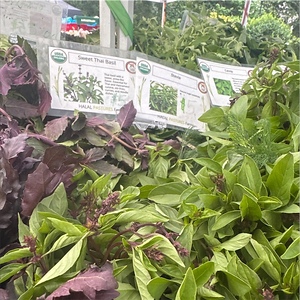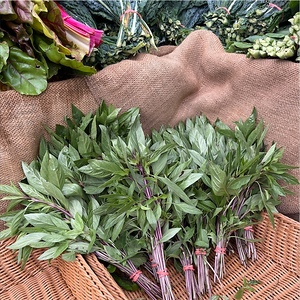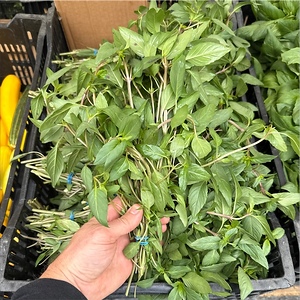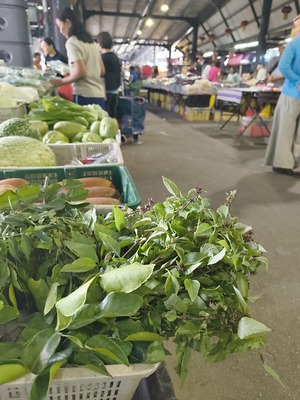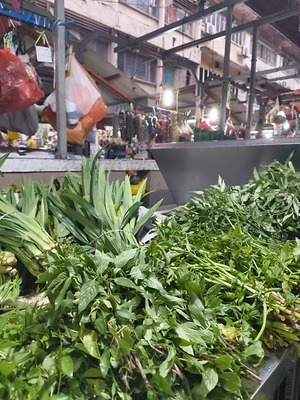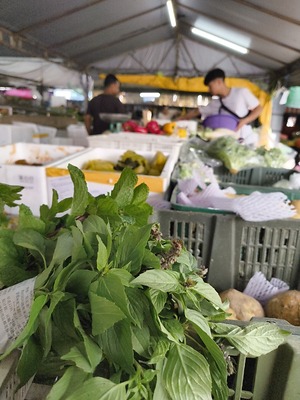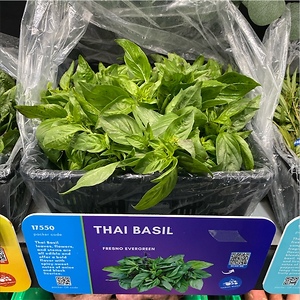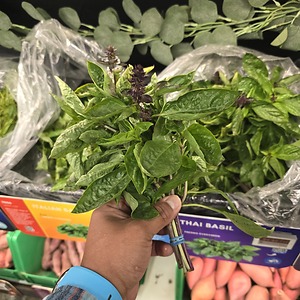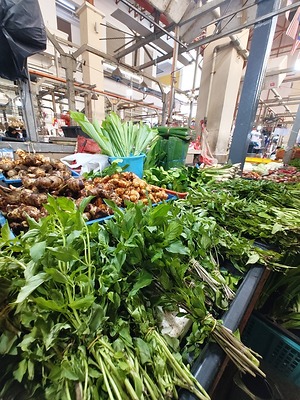

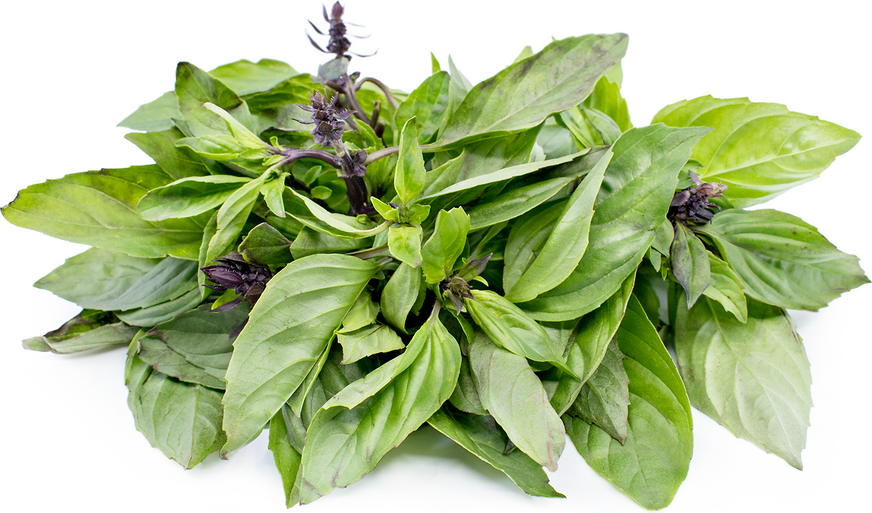
Thai Basil
Estimated Inventory, lb : 68.93
This item was last sold on : 07/17/25
Description/Taste
Thai Basil is a perennial herb that grows to an average of 30 to 45 centimeters in height and spreads about 30 centimeters wide. The narrow, bright-green leaves have serrated edges and are typically smaller and sturdier than those of common sweet basil. They also boast a fresh and spicy fragrance and sometimes have a slight purple tint. When the plant matures, spikes of lavender to dark-violet flowers grow at the tops of the reddish-purple stems. Thai Basil leaves, flowers, and stems are all edible and offer a bold flavor with spicy-sweet notes of anise and black licorice.
Seasons/Availability
Thai Basil is available year-round.
Current Facts
Thai Basil is botanically classified as Ocimum basilicum var. thyrsiflora and is a member of the mint family. It’s not just a single plant but rather one of three common groupings of basil cultivars: Thai, sweet, and holy basil. Thai Basil plants are cultivated Asian varieties of sweet basil known for their spicier flavor and ability to withstand high cooking temperatures. While many types of Thai Basil are grown worldwide, the most popularly cultivated is Siam Queen, known for its larger leaves and distinct black licorice flavor. Despite belonging to separate species, Thai Basil is often mistaken for holy basil, also referred to as Thai holy basil. Thai Basil offers a more robust, sweet yet spicy anise-like flavor, while holy basil has a more peppery clove-like taste. Another case of mistaken identity stems from the flavor of Thai Basil, which has led to the nickname Licorice Basil. However, that’s not to be conflated with a variety called licorice or Persian basil, a type of sweet basil with a similar licorice-like flavor.
Nutritional Value
Thai Basil has notably high levels of vitamin A, which is beneficial for healthy eyes and skin, and vitamin K, which promotes bone health. It also offers significant amounts of vitamin C, magnesium, calcium, iron, and potassium. The seeds are edible, and they pack a nutritional punch of magnesium, calcium, and fiber. Basil is known for its essential oil, which includes compounds like eugenol and limonene that possess antibacterial, anti-inflammatory, and antioxidant properties.
Applications
Thai Basil is most often used fresh or cooked and is a popular ingredient in Southeast Asian cuisines like Thai, Cambodian, Lao, and Vietnamese. Unlike sweet basil, Thai Basil has sturdy and resilient leaves that stand up to prolonged heat and cooking. Hence, it's well-suited for infusing flavor into broths and soups, from traditional Vietnamese Pho to Thai green or Panang curries. While sweet basil may be used as a substitute in some recipes, Thai Basil is worth seeking out for more traditional dishes that highlight the spicy flavor and sturdy texture, such as Vietnamese spring rolls. Vice versa, Thai Basil may be used in place of common sweet basil to impart a bolder herb flavor with a licorice kick. Thai Basil works equally well in simmered dishes, like Taiwanese braised eggplant, high-heat wok stir-fries, and noodle dishes like pad Thai. It pairs well with chicken, beef, shrimp, tofu, eggplant, potato, bell pepper, tomato, eggs, rice, garlic, chili, oregano, mint, lemongrass, and coconut milk. Fresh Thai Basil leaves can even be used as a garnish and aromatic in cocktails and beverages like lemonade or used in sweet applications like fruit salads, pairing well with mango, pineapple, watermelon, lemon, figs, and stone fruit. As all parts of the plant are edible, try adding the flowers to salads, chopping the stems into rice, or soaking the seeds, similar to chia seeds, to use in pudding, smoothies, or desserts. Store fresh Thai Basil in a glass of water at room temperature after cutting the ends of the stems, like you would a bouquet of flowers, or wrap in a paper cloth and stored in a bag in the refrigerator for a week or two. Thai Basil can also be dried or frozen to prolong its use.
Ethnic/Cultural Info
Thai Basil is a kitchen staple in Southeast Asian countries like Thailand and Vietnam, where it is often regarded as a vegetable rather than simply an herb or garnish. In Thailand, Thai Basil is called Bai Horapa, and in Vietnam, it is known as Rau Hung Que, which translates as “cinnamon mint.” Thai Basil stars in pad gra prow, a Thai stir-fry beef dish, and gai pad nam prik pao, a famous Thai dish made with chicken and roasted chili paste. Thai Basil is also often served with larb, a minced meat salad that’s one of the most popular dishes of Laos.
Geography/History
Thai Basil is native to Southeast Asia, though its exact origin is somewhat debated since its history of cultivation dates back approximately 5,000 years. Many believe that it originated in either India or Asia and spread to the Mediterranean via ancient spice routes, however some experts now think it might originally have come from Iran. Today, basil is commonly grown in Italy, France, Egypt, Morocco, California, and other warm climates worldwide. Thai Basil can be grown at home or found at specialty stores and Asian markets.
Featured Restaurants
Restaurants currently purchasing this product as an ingredient for their menu.
| The Country Club Of Rancho Bernardo | San Diego CA | 858-487-1134 |
| Toast Cafe | San Diego CA | 858-208-9422 |
| Grass Skirt | San Diego CA | 858-412-5237 |
| LANA Bar | Solana Beach CA | 602-758-2596 |
| The Lion Share Bar 2025 | San Diego CA | 619-564-6924 |
| Park Hyatt Aviara (Ember & Rye) | Carlsbad CA | 760-448-1234 |
| Hyatt Islandia | San Diego CA | 619-224-1234 |
| Sushi Nekosan | La Jolla CA | 858-999-0999 |
| Harvest Kitchen | Vista CA | 619-709-0938 |
| Gravity Heights Restaurant and Brewery | San Diego CA | 858-551-5105 |
| Inn at Rancho Santa Fe | Rancho Santa Fe CA | 858-381-8289 |
| The Crack Shack PB | San Diego CA | 619-450-7978 |
| Coral Del Mar | Del Mar CA | 858-449-6679 |
| Nolita Hall | San Diego CA | 619-618-8820 |
| Georges at the Cove | San Diego CA | 858-454-4244 |
| Roppongi (IB) | Imperial Beach CA | 858-456-8018 |
| Common Theory | San Diego CA | 858-384-7974 |
| Kingfisher | San Diego CA | 619-861-8074 |
| Gravity Heights Mission Valley | San Diego CA | 619-384-5993 |
| Hotel La Jolla - Sea & Sky | La Jolla CA | 858-459-0261 |
| Lodge at Torrey Pines Grill | San Diego CA | 858-453-4420 |
| Bar Same Same (Kitchen) | Carlsbad CA | 760-470-9143 |
| Yoann Taboyan, Personal Chef | San Diego CA | 347-277-1958 |
| Addison Del Mar | Del Mar CA | 858-350-7600 |
| Stone Brewing World Bistro & Gardens | Escondido CA | 915-861-2297 |
| Panama 66 | San Diego CA | 619-206-6352 |
| UCSD Health East campus | San Diego CA | 619-578-3373 |
| Park Hyatt Aviara | Carlsbad CA | 760-448-1234 |
| Captains Quarters | San Diego CA | 858-412-5237 |
| The Remy | San Diego CA | 619-886-1358 |
| Snake Oil Cocktail Company LLC | San Diego CA | 619-754-4041 |
| Grass Skirt (Bar) | San Diego CA | 858-412-5237 |
| Animae | San Diego CA | 619-925-7908 |
| Moxy San Diego Gaslamp | San Diego CA | 619-376-1850 |
| Urban Kitchen Catering | San Diego CA | 619-276-8803 |
| Small Barn | Temecula CA | 951-225-2822 |
| Choi's | San Diego CA | 858-900-1224 |
| PureTaco | Carlsbad CA | 760-845-3346 |
| Starlite Kitchen | San Diego CA | 619-358-9766 |
| Crust Pizzeria Solana Beach | Solana Beach CA | 858-212-8751 |
| La Valle Coastal Club | Rancho Santa Fe CA | 858-759-5473 |
| Leu Leu | Leucadia CA | 619-316-5807 |
| Shoreside Support Boat | San Diego CA | 704-277-7929 |
| Harney Sushi | San Diego CA | 619-295-3272 |
| Pacific Yacht Agents | Los Angeles CA | 808-214-0970 |
| Duke's La Jolla | La Jolla CA | 858-454-1999 |
| Under Belly-Uptown | San Diego CA | 619-269-4626 |
| Toast Catering | San Diego CA | 619-795-9135 |
| University Club | San Diego CA | 619-234-5200 |
| Institutes of Health LLC | San Diego CA | 800-270-5016 |
| Animae (Bar) | San Diego CA | 619-925-7908 |
| Lafayette Hotel - Quixote | San Diego CA | 619-296-2101 |
| Plant Based Meals | San Diego CA | 858-255-0590 |
| San Diego Yacht Club | San Diego CA | 619-758-6334 |
| Steady State Roasting | Carlsbad CA | 760-908-1680 |
| Pacific Coast Grill | Solana Beach CA | 858-794-4632 |
| Rosewood Social | San Juan Capistrano CA | 669-243-8403 |
| Farm Fresh Meals | Vista CA | 760-707-2383 |
| Fox Point Farms (Haven) | Encinitas CA | 619-892-0553 |
| Solana Beach Kitchen | Solana Beach CA | 610-717-7217 |
| Javier Plascencia (Animalon) | Bonita CA | 619-295-3172 |
| C 2 C | San Diego CA | 619-972-9345 |
| Far Corner | San Diego CA | 619-549-0838 |
| Coast Catering | Escondido CA | 619-295-3173 |
| Fifty Two Remedies | San Diego San Diego | 858-707-7016 |
| Convention Center Shell | San Diego CA | 619-954-3063 |
| Beaumont's | San Diego CA | 858-459-0474 |
| Paradisaea Restaurant | La Jolla CA | 732-915-6669 |
| Lafayette Hotel - Beginners Diner | San Diego CA | 619-296-2101 |
| Pali Wine Company | San Diego CA | 310-893-0038 |
| Misadventure & Co. | Vista CA | 469-580-1146 |
| Kettner Exchange | San Diego CA | 909-915-9877 |
| Cosecha Local | San Diego CA | 646-132-5944 |
| Viejas Casino Ginger Noodle | Alpine CA | 702-401-0455 |
| Wormwood (Bar) | San Diego CA | 619-573-0289 |
| Sovereign Thai Cuisine | San Diego CA | 619-887-2000 |
| Valley View Casino & Hotel | Valley Center CA | 760-291-5500 |
| Herb & Wood Bar | San Diego CA | 619-955-8495 |
| Saiko Sushi-Coronado | Coronado CA | 619-435-0868 |
| Birdseye Rooftop | San Diego CA | 619-206-7220 |
| SIE Culinary Management | San Diego CA | 858-964-8677 |
| Campfire | Carlsbad CA | 760-637-5121 |
| Nolita Hall - Bar | San Diego CA | 619-618-8820 |
| Espadin | Temecula California | 951-383-5585 |
| The Shores | La Jolla CA | 858-459-8271 |
| Make Stuff Good | San Diego CA | 949-547-9470 |
| Pendry SD (Lion Fish) | San Diego CA | 619-738-7000 |
| Polaris Supreme | San Diego CA | 619-390-7890 |
| The Wild Thyme Company | San Diego CA | 858-527-0226 |
| Hilton Harbor Island | San Diego CA | 619-291-6700 |
| Books and Records | San Diego CA | 619-310-5298 |
| Belmont Park Cannonball | San Diego CA | 858-228-9283 |
| Lucien | La Jolla CA | 707-387-7163 |
| Fort Oak | San Diego CA | 619-795-6901 |
| La Jolla Country Club | San Diego CA | 858-454-9601 |
| Fishery | San Diego CA | 858-272-9985 |
| Lovesong | San Diego CA | 602-502-3460 |
| Trust Restaurant | San Diego CA | 609-780-7572 |
| Fifty Two Remedies Bar | San Diego CA | 858-707-7016 |
| Carte Hotel | San Diego CA | 619-365-1858 |
| Communion (Paradis) | San Diego CA | 619-606-5568 |
| Humphrey's | San Diego CA | 619-224-3577 |
| Terra Restaurant | San Diego CA | 619-293-7088 |
| Rancho Santa Fe Golf Club | Rancho Santa Fe CA | 858-756-1582 |
| Counterpoint | San Diego CA | 619-564-6722 |
| Lucky Bolt | San Diego CA | 662-832-3638 |
| Lost Cause Meadery | SAN DIEGO CA | 858-245-1911 |
| Lilo | Carlsbad CA | 619-385-0914 |
Recipe Ideas
Recipes that include Thai Basil. One



